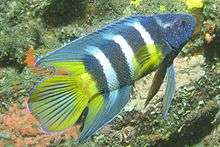Paraplesiops bleekeri
| Paraplesiops bleekeri | |
|---|---|
 | |
| Scientific classification | |
| Kingdom: | Animalia |
| Phylum: | Chordata |
| Class: | Actinopterygii |
| Order: | Perciformes |
| Family: | Plesiopidae |
| Genus: | Paraplesiops |
| Species: | P. bleekeri |
| Binomial name | |
| Paraplesiops bleekeri (Günther, 1861)[1][2][3] | |
| Synonyms | |
|
Plesiops bleekeri Günther, 1861[3] | |
Paraplesiops bleekeri, commonly known as the eastern blue devil, blue-tipped long-fin or Bleeker's blue devil fish, is a species of fish in the family Plesiopidae. This colourful, secretive fish is endemic to Australia, where it is a protected species.
Description
This species grows to 40 cm, and is recognizable by blue and white bands on the body, blue spots on the head, and blue dorsal and anal fins. It also has a yellow base, pectoral, and caudal fins. The pelvic, posterior dorsal, and anal fins are all elongated.[4][5]
This species is a close relative of the southern blue devil (Paraplesiops meleagris), which lives in the colder southern Australian waters.[1]
Distribution
The fish is found in coastal waters of eastern Australia between the Gold Coast of southern Queensland and Montague Island,[1] most commonly between Sydney and Ulladulla.[4]
Behaviour
This species is shy and secretive. Males have appeared to defend territories in caves or overhangs, where it remains to attract females and drive males away.[4] They are most active at night.
Habitat
Paraplesiops bleekeri are benthic, inshore reef inhabitants. They live inside caves, under ledges and overhangs in inshore reefs and estuaries. They also inhabit offshore waters ranging from 3 to 30 metres in depth.[1][4]
Diet
This fish is known to eat brittle stars.
Conservation status
This species is protected under the laws of New South Wales Fisheries, in particular, the Fisheries Management Act 1994. It is illegal to collect or possess them without a permit.[1][4]
They are protected because of their low abundance, and their desirability in the marine aquarium industry.
Efforts to protect them have included the conservation and protection of benthic estuarine habitats, as well as rocky offshore reef areas where they breed. Some protected habitats are:
- Solitary Islands Marine Park
- Port Stephens – Great Lakes Marine Park
- Jervis Bay Marine Park
- Long Reef Aquatic Reserve
- Bushrangers Bay Aquatic Reserve[5]
References
- 1 2 3 4 5 Eastern Blue Devil, Paraplesiops bleekeri (Günther, 1861) – Australian Museum
- ↑ Paraplesiops bleekeri, Eastern blue devil : aquarium
- 1 2 WoRMS – World Register of Marine Species – Paraplesiops bleekeri (Günther, 1861)
- 1 2 3 4 5 Eastern Blue Devil Fish Paraplesiops bleekeri
- 1 2 http://www.dpi.nsw.gov.au/__data/assets/pdf_file/0005/77396/Eastern-blue-devil-fish-Primefact-165---final.pdf
Further reading
- Eschmeyer, William N., ed. 1998. Catalog of Fishes. Special Publication of the Center for Biodiversity Research and Information, no. 1, vol. 1–3. California Academy of Sciences. San Francisco, California. 2905. ISBN 0-940228-47-5.
- Fenner, Robert M.: The Conscientious Marine Aquarist. Neptune City, New Jersey: T.F.H. Publications, 2001.
- Helfman, G., B. Collette y D. Facey: The diversity of fishes. Blackwell Science, Malden, Massachusetts, 1997.
- Hoese, D.F. 1986: . A M.M. Smith y P.C. Heemstra (eds.) Smiths' sea fishes. Springer-Verlag, Berlin.
- Hoese, D. F. and R. H. Kuiter 1984. "A revision of the Australian plesiopid fish genus Paraplesiops, with notes on other Australian genera"; Records of the Australian Museum v. 36: 7–18.
- Maugé, L.A. 1986. A J. Daget, J.-P. Gosse and D.F.E. Thys van den Audenaerde (eds.) Check-list of the freshwater fishes of Africa (CLOFFA). ISNB Brussels; MRAC, Tervuren; and ORSTOM, Paris. Vol. 2.
- Moyle, P. y J. Cech.: Fishes: An Introduction to Ichthyology, 4th edition, Upper Saddle River, New Jersey: Prentice-Hall, 2000.
- Nelson, J.: Fishes of the World, 3rd edition. New York City: John Wiley and Sons, 1994.
- Paxton, J.R., D.F. Hoese, G.R. Allen and J.E. Hanley 1989: "Pisces. Petromyzontidae to Carangidae", Zoological Catalogue of Australia, Vol. 7. Australian Government Publishing Service, Canberra, 665 pp.
- Wheeler, A.: The World Encyclopedia of Fishes, 2nd edition, London: Macdonald, 1985.